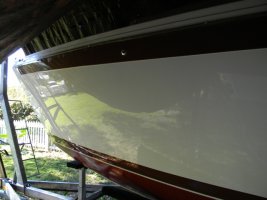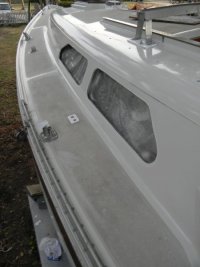This is a Really Big Job. I did it twice because the temperature dropped too much the first time and the paint didn't dry properly. I used System 3 the first time since it was supposed to be less toxic, and it totally failed. In my research I found reports of Brightsides only lasting a few years so I went with the finicky two part Interlux Perfection the second time around. It turned out really nice and still looks new 4 years later. I had the boat in a shelter so I could control rain and dust and bugs and (sometimes) temperature. You will have to clean any polishing compound off the boat before you sand, or it gets sanded into the gelcoat, and the paint may not adhere properly. If silicone sealant was used anywhere, forget about painting that area. You may be able to remove some of it with various deadly chemicals (even more deadly than the two-part paint, which contains isocyanate and will kill you if you breathe it-not sure how bad Brightsides is). But areas with silicone will be at risk of failing to properly adhere. Make sure you use the right sandpaper (if you can find it and don't mind paying an arm and a leg for it). Most of the sandpaper available at home improvement stores contain stearate anti-stick compound which are not compatible with some paints. So if you don't use the right sandpaper, anywhere you sand the paint may fail to adhere. Any for epoxy repairs, don't forget to wash the amine blush off, or, you guessed it, the paint may fail to adhere. And that is the easy part! Prime it, sand it, clean it, then the tricky part, getting the paint mixture just right so it flows, but doesn't drip. And this mix changes based on temperature, direct sun, indirect sun, humidity, wind, etc. While you are painting, maintain a wet edge at all times or you get brush marks. Roll with a foam brush (but not too thick), then tip with an expensive china bristle brush. Each foam roller lasts about 12 minutes before the solvents start to get to it and it expands into a useless mushy mess. So a dozen packs of foam rollers and 3 or 4 of the expensive brushes should get you through. Let the first coat, dry, then sand (use the right sandpaper!!!!), clean and repeat. Practice your yoga for a few weeks before, since you will have to be in unusual positions to reach over areas you have already painted. All this while wearing a bunny suit, respirator, goggles and expensive nitrile gloves so the paint doesn't kill you or make you sick. And never, ever drop a full tray of paint all over the side of the boat!:0
This is a long way of saying that if there is any way that you can work on the gelcoat as Roscoe did, you should go for it.
Good luck.


